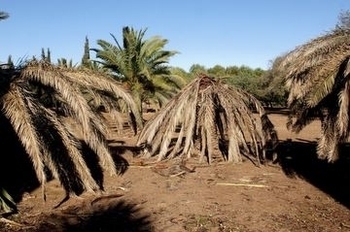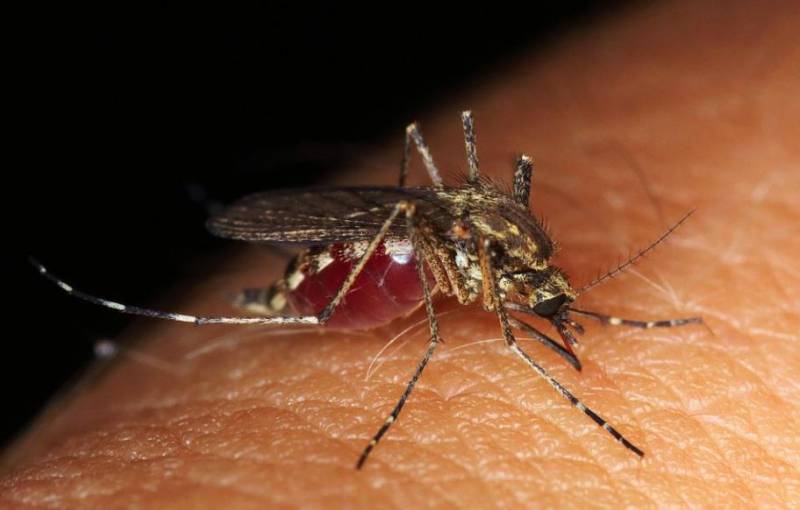- Region
- Vega baja
- Marina Alta
- Marina Baixa
- Alicante
- Baix Vinalopo
- Alto & Mitja Vinalopo
-
ALL TOWNS
- ALICANTE TOWNS
- Albatera
- Alfaz Del Pi
- Alicante City
- Alcoy
- Almoradi
- Benitatxell
- Bigastro
- Benferri
- Benidorm
- Calosa de Segura
- Calpe
- Catral
- Costa Blanca
- Cox
- Daya Vieja
- Denia
- Elche
- Elda
- Granja de Rocamora
- Guardamar del Segura
- Jacarilla
- Los Montesinos
- Orihuela
- Pedreguer
- Pilar de Horadada
- Playa Flamenca
- Quesada
- Rafal
- Redovan
- Rojales
- San Isidro
- Torrevieja
- Comunidad Valenciana
La Cochinilla del Carmin is destroying vast tracts of prickly pears
 Chumberas, prickly pears, problems
Chumberas, prickly pears, problems
A new pest threatens to wipe out the emblematic prickly pears that form part of the traditional Spanish landscape, sweeping down from the North of the region and leaving ugly blotches as it destroys vast tracts of cultivated chumberas.
Its immediately visible.
How to identify the Cochinilla del Carmin
The chumberas assume a whitish hue, and within a short time white, fluffy splotches appear, to the untrained eye as though the plant has been spattered with white paint, spreading across the plant at frightening speed, until the plant turns brown and dies, leaving a large clump of rotting plant material.
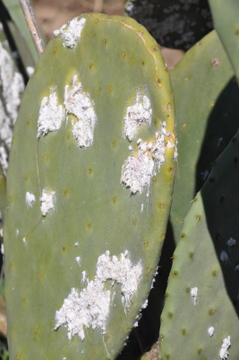
The red substance is the key to what this problem is- a relation of the cultivated cochineal beetle used to manufacture cochineal dye, which appears in all manner of cosmetic, food and textile products, the same family as the scale insects which regularly show up on mimosas, citrus trees and ornamentals.( More info about the fluted scale insect.)
This particular variety is called La Cochinilla del Carmin, wild cochinilla, Dactylopius , native of Central America.
There are many varieties of Dactylopius, the most famous being Dactylopius Coccus, which is cultivated extensively in the Canary Islands for cochineal extraction, whilst others are used as a biological control, but this particular pest, Dactylopius opuntiae, has no practical use and devastates prickly pears, which are the only plant on which it can survive.
The females have no wings and are incapable of flying, so lay their eggs beneath a protective, cottony layer, each female producing an average of 130 offspring during the 80 day period of her lifespan. The young excrete a sticky thread like substance, which is how the insect spreads so quickly, the wind picking them up and blowing them across onto other leaves, or carrying them some distance.

It must be stressed, however, that whilst they are a nuisance, they cannot bite like mosquitos, so cause no actual harm, other than leaving a red spatter, which often gives the wrongful impression that they have drawn blood.
The Ministry of Agriculture are monitoring the spread of the Dactylopius in Murcia and make the following recommendations .
What to do if you have a problem with Cochinilla del Carmin
If the presence is minimal, rub off the cottony substance, and scrub with water and washing up liquid. As with other scale insect family members, washing up liquid breaks down the protection of the cottony mass, removes UVA protection, and the tiny insects hiding beneath the cotton mass are killed by the sunlight.
If the infestation is more widespread , spray with clorpirifos mixed with a little drop of olive oil, which helps it to stick to the insects .
As with all chemical spraying, protective clothing and eye protection should be worn and windy days avoided, or contract a professional.
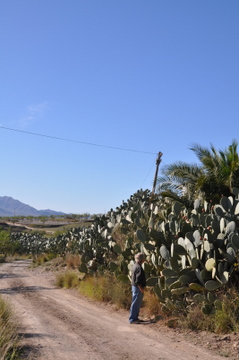
Failure to treat will result in the destruction of the plants , as the feeding nymphs suck the plant dry.
This leaves an ugly, brown heap, which collapses and rots, attracting flies with a most unpleasant smell, so if you see signs of this infestation on prickly pears, act immediately otherwise it will spread across every plant in the vicinity and kill the lot.
At the moment there is no help available from the Ministry of Agriculture or the region, although the spread of the Cochinilla is being closely monitored and assessed.
We became aware of this problem when one of the Gardening club members contacted us to ask if we could recommend a treatment, and arriving to photograph the pest to help identify it, were horrified by the extent of the infestation. Since then, we have become aware of large patches around the area , and having received the official information from the Ministry, now realise what a serious problem it is for anyone with prickly pears near to their homes.
Although the Cochinilla is most active during warmer weather, it should still be treated immediately to prevent its spread.
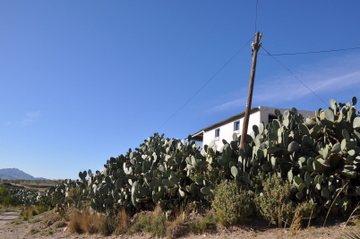
Update Jan 2012.
Sadly the scale of the problem has become so widespread that many have given up all attempts at spraying or treating this pest, and vast areas of prickly pears have disappeared. Clumps will resprout if some treatment is administered, and the old Spanish cut off all the leaves, just leaving stumps to facilitate this.Constant treatment will keep the pests at bay, but it has to be regular, as the wind simply blows in more.
.




























